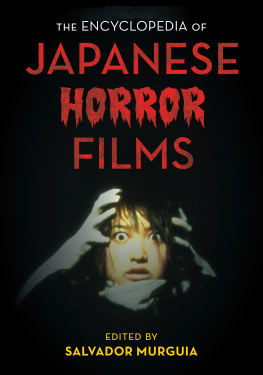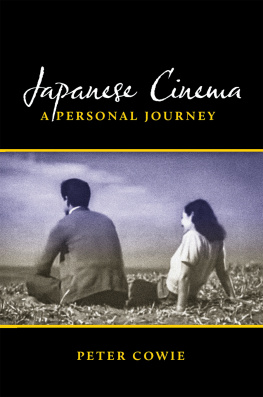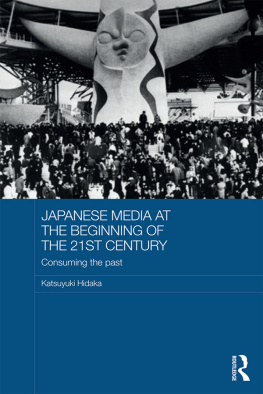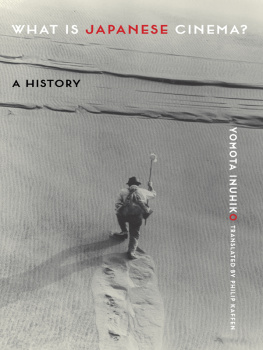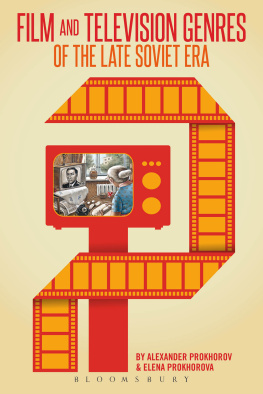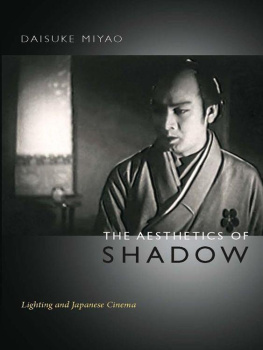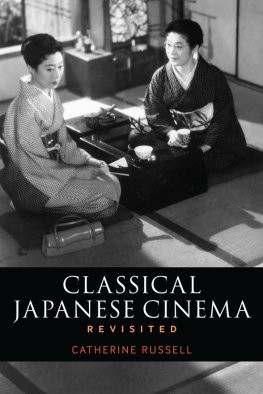I am indebted to many people for their help and support in the production of this work, in particular I would like to thank my supervisors at the University of London, School of Oriental and African Studies, Professor Drew Gerstle and Dr Lola Martinez, as well as my two PhD examiners Dr Mark Morris and Dr Brian Powell for their many helpful suggestions. I would also like to thank the Ouseley Memorial Scholarship for the three years of financial support and the Japan Foundation for the Fellowship I received enabling me to study under the film historian, Professor Iwamoto Kenji, at Waseda University in Tokyo. Finally, I would also like to thank the Nagasawa family for their friendship and support.
All the illustrations included in this work were taken by the author from video prints produced by the following companies. Nikkatsu (Gonin no sekkhei), Nihon ATG (Nikudan), Shin Th (Ningen gyorai kaiten), Shchiku (Ningen no jken), Tei (Abashiri bangaichi) and (jingi naki tatakai). The illustrations for Kumo nagaruru hateni were taken from a video of an NHK screening of the film. Without access to these and the many other Japanese films available for private viewing in Japan on video, this study would not have been possible.
Allen, Robert C. and Douglas Gomery. (1985) Film History: Theory and Practice, London: McGraw-Hill.
Alperovitz, Gar (1994) Atomic Diplomacy: Hiroshima and Potsdam, London: Pluto Press.
Althusser, Louis. (1971) Lenin and Philosophy and Other Essays, (trans.) Ben Brewster. New York: Monthly Review Press.
___ (1990) For Marx, (trans.) Ben Brewster. London: Verso.
Anderson, Benedict. (1993) Imagined Communities: Reflections on the Origin and Spread of Nationalism, London: Verso.
Anderson, J.T. and D. Richie. (1959) The Japanese Film: Art and Industry, Tokyo: Tuttle.
Apter, David E. and Nagayo Sawa. (eds.) (1984) Against the State: Politics and Social Protest in Japan, Cambridge, Mass: Harvard University Press.
Ashihara, Yoshinobu. (1992) The Hidden Order: Tokyo Through the Twentieth Century, (trans.) Lynne E. Riggs, Tokyo: Kodansha.
Bachnick, Jane M. and Charles J. Quinn, (eds.) (1994) Situated Meaning: Inside and Outside in Japanese Self, Society and Language, Chichester: Princeton University Press.
Balzs, B. The Theory of Film: The Close-up. Film Theory and Criticism, (1979) (eds.) G. Mast and M. Cohen. New York: Oxford University Press. p. 288-298.
Barrett, Gregory. (1989) Archetypes in Japanese Film: The Sociopolitical and Religious Significance of the Principal Heroes and Heroines, Selinsgrove: Susquehanna University Press.
Barthes, Roland. (1975) The Pleasure of the Text, (trans.) R. Miller, New York: Hill and Wang.
___ (1981) Mythologies, (trans.) Annette Lavers. 5th ed. London: Granada Publishing.
___ (1982) Empire of the Signs, (trans.) Richard Howard. New York: Hill and Wang.
Baudrillard, Jean (1993) Symbolic Exchange and Death, (trans.) Iain Hamilton Grant. London: Sage Publications.
Beasley, WG. (1973) The Meiji Restoration, London: Oxford University Press.
___ (1989) Japanese Imperialism 1894-1945, Oxford: Clarendon Press.
___ (1990) The Rise of Modern Japan, London: Weidenfeld and Nicolson.
Behr, Edward. (1989) Hirohito: Behind the Myth, London: Hamish Hamilton.
Bentham, Jeremy. (1988) The Principles of Morals and Legislation, New York: Prometheus.
___ (1995) The Panopticon Writings, (ed.) Miran Bozovic. London: Verso.
Bordwell, David. (1988) Ozu and the Poetics of Cinema, London: BFI Publishing.
___ (1989) Making Meaning: Inference and Rhetoric in the Interpretation of Cinema, London: Harvard University Press.
Bordwell, David and Kristin Thompson. (1980) Film Art: An Introduction, 2nd ed. Reading, Massachusetts: Addison Wesley Publishing.
Bornoff, Nicholas. (1991) The Pink Samurai: The Pursuit and Politics of Sex in Japan, London: Grafton Books.
Braw, Monica. (1991) The Atomic Bomb Suppressed: American Censorship in Occupied Japan, London: M.E. Sharpe.
Buehrer, Beverley Bare. (1990) Japanese Films: A Filmography and Commentary, 1921-1989, London: St. James Press.
Bungei Shunj (eds.) (1992) Nihon Eiga Besuto 150: Daiankto ni yoru, Tky: Bungei Shunj.
Burch, Nol. (1979) To the Distant Observer: Form and Meaning in the Japanese Cinema, London: Scolar Press.
___ (1983) Theory of Film Practice, (trans.) Helen R. Lane. 3rd ed. London: Martin Seeker and Warburg.
Burgoyne, Robert. (1994) National Identity, Gender Identity and the Rescue Fantasy in Born on the Fourth of July. Screen, vol.35, no.3, Autumn, p. 211-234.
Burnett, Ron. (ed.) (1991) Explorations in Film Theory: Selected Essays from Cin-Tracts, Bloomington and Indianapolis: Indiana University Press.
Buruma, Ian. (1988) A Japanese Mirror: Heroes and Villains of Japanese Culture, 2nd ed. London: Penguin Books.
___ (1994) Wages of Guilt: Memories of War in Germany and Japan, London: Jonathan Cape.
Calman, Donald. (1992) The Nature and Origins of Japanese Imperialism: A Reinterpretation of the Great Crisis of 1873, London: Routledge.
Carr, E.H. (1990) What is History?, (ed.) R.W. Davies. 2nd ed. London: Penguin Books.
Chomsky, Noam. (1993a) Deterring Democracy, London: Vintage.
___ (1993b) Necessary Illusions: Thought Control in Democratic Societies, London: Pluto Press.
___ (1993c) Year 501: The Conquest Continues, London: Verso.
Cohan, S. and I.R. Hark, (eds.) (1993) Screening the Male: Exploring Masculinities in Hollywood Cinema, London: Routledge.
Corrigan, Timothy. (1991) A Cinema Without Walls: Movies and Culture after Vietnam, New Brunswick, New Jersey: Rutgers University Press.
Craig, S. (ed.) (1992) Men, Masculinity and the Media, California: Sage Publications.
Crowley, J.B. (1996) Japans Quest for Autonomy: National Security and Foreign Policy 1930-1938, New Jersey: Princeton University Press.
Custen, G.F. (1992) Bio-pics: How Hollywood Constructed Public History, New Jersey: Rutgers University Press.
Dale, Peter N. (1990) The Myth of Japanese Uniqueness, London: Routledge.
Debord, Guy. (1995) The Society of the Spectacle, (trans.) D. Nicholson-Smith. New York: Zone Books.
Denzin, Norman. K. (1991) Images of Postmodern Society: Social Theory and Contemporary Cinema, London: Sage Publications.
Desser, David. (1988) Eros Plus Massacre: An Introduction to the Japanese New Wave Cinema, Bloomington and Indianapolis: Indiana University Press.
De Voss, George A. (1973) Socialization for Achievement: Essays on the Cultural Psychology of the Japanese, London: University of California Press.
Dissanayake, Wimal. (1992) Cinema, Nation, and Culture in Southeast Asia: Enframing a Relationship. East-West Film Journal, vol.6, no.2, July, p. 1-22.
Dittmar, Linda and Gene Michaud. (eds.) (1990) From Hanoi to Hollywood: The Vietnam War in American Film, London: Rutgers University Press.
Doi, Takeo. (1981) The Anatomy of Dependence: The Key Analysis of Japanese Behaviour, London: Kodansha.
Dower, John. W. (1986) War Without Mercy: Race and Power in the Pacific War, New York: Pantheon Books.
___ (1988) Empire and Afermath: Yoshida Shigeru and the Japanese Experience, 1878-1954, London: Harvard University Press.


